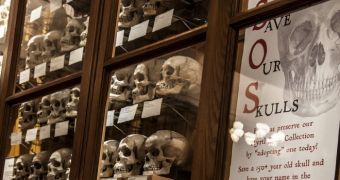A unique collection of skulls from the Mutter Museum in Philadelphia is in need of restoration and remounting after it was damaged by vibrations of the visitors’ footsteps. In order to raise the funds needed, the Museum staff came up with the idea of starting the “Save Our Skulls” program.
The interesting and gruesome collection holds 139 skulls gathered by scientist Josef Hyrti back in the 1800s to prove one of the time’s most controverted beliefs, that the shape of the skull can determine someone's morality and that different races were actually different species as well.
Every skull holds a weird story of how the person died and were all included in a catalog to help people decide on the new adoption. The $200 (€145) donations will help the restoration project and will put the sponsor's name on a small wooden plate next to his item of choice.
The skulls mostly belonged to people who died in jail or from epidemics and who committed suicide as the scientist who gathered them didn't want to face the resistance of relatives. His collection was rumored to have included the services of a grave robber and, besides the 139 human skulls, he also had 800 fish skeletons and almost 300 ears from different kind of animals.
Well, it's a fact that the man had a weird hobby but scientists of the time did even more bizarre things for the sake of research. Hyrti guided his scientific research after “phrenology,” or the assumption that the brain was made from discrete mental organs, each with a specific function, and the size of the organs showed the mental facility of the persons, according to Wired.
With his varied skull collection, he wanted to show that diversity was as present in the so-called superior race of the European Caucasian population as in the other racial groups, considered inferior at the time.
The collection meant to crush racial stereotypes is exhibited in the Mutter Museum's mezzanine for more than 100 years. The Save Our Skulls campaign was launched in an attempt to raise enough money to change the mounts of the skulls that transmitted vibrations from visitors’ footsteps to the fragile collection.

 14 DAY TRIAL //
14 DAY TRIAL //